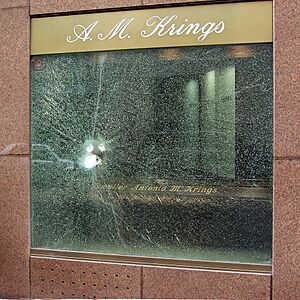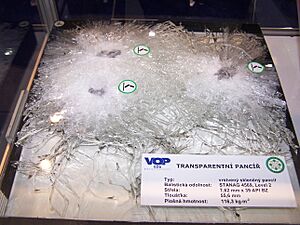Bullet-proof glass facts for kids
Bullet-resistant glass, often called bulletproof glass, is a special type of strong, clear material. It's designed to stop bullets from going through it. However, it's important to know that no glass can offer complete protection against all types of weapons.
This special glass is usually made from several layers of different materials. There's typically a hard layer and a softer, more flexible layer. The softer layer helps the glass bend a little instead of just shattering when hit. This makes it much tougher. Even with these layers, you can still see clearly through the glass. Bullet-resistant glass can be quite thick, ranging from about three-quarters of an inch to three inches.
Sometimes, a special plastic film is added to the inside of regular glass. This film, called a 'security laminate', sticks firmly to the glass. It offers protection similar to the multi-layered bullet-resistant glass. This method can make the glass clearer and much thinner and lighter. This laminate can even be added to windows that are already in place, which is called a 'retrofit'.
Contents
How Bullet-Resistant Glass Works
The Basic Idea
The plastic layers in bullet-resistant glass don't stop bullets on their own. Instead, the very hard glass layers flatten the bullet. Then, the softer plastic layers absorb the bullet's energy. This helps to slow down and eventually stop the bullet. The thicker the plastic layer, the better it is at stopping projectiles.
What It's Made Of
All the parts of bullet-resistant glass must be see-through. The main parts are:
- A very hard material, like special glass or a hard plastic.
- A softer plastic that can bend when heated and pressed.
- A sticky material (an adhesive) to hold the layers together.
Today, the most common way to make it involves three main layers:
- Outside layer: This is usually glass that has been made extra strong. Sometimes, a very hard, clear plastic called acrylic (also known as 'Perspex' or 'Plexiglas') is used instead of or with glass.
- Middle layer: This is an adhesive, often a type of resin called polyvinyl butyal. This sticky layer bonds the other parts together.
- Inside layer: This is a flexible plastic called polycarbonate.
Simple Version for Cars
A simpler version of this technology is used in car windshields. It has two panels of toughened glass stuck together with polyvinyl butyal (PVB). The PVB helps stop cracks in the outer glass from spreading.
New Ideas for Tougher Glass
One-Way Protection
Some special glass is designed to be 'one-way' bulletproof. This means people inside can shoot out, but attackers can't shoot in. This type of glass usually has two layers: a brittle (easily broken) layer on the outside and a flexible layer on the inside.
When a bullet hits from the outside, it first hits the brittle layer. This layer shatters, which absorbs some of the bullet's energy and spreads it out. When the slowed bullet then hits the flexible inner layer, it stops.
However, if a bullet is fired from the inside, it hits the flexible layer first. The bullet goes through this layer because its energy is focused on a small spot. The brittle outer layer then shatters outwards, not stopping the bullet much. A challenge with this design is that two layers might not stop very powerful bullets.
Better Materials Than Glass
Scientists are developing new types of clear armor using materials like aluminium oxynitride. This material is much lighter and stronger than traditional glass and plastic layers. It can even stop very powerful armor-piercing bullets. Other glass-like materials are also being developed.
Using Ceramics
Certain types of ceramics can also be used to make clear armor. Ceramics are denser and harder than regular glass. These new ceramic armors can be thinner than traditional layered glass but still offer the same strong protection.
Images for kids



